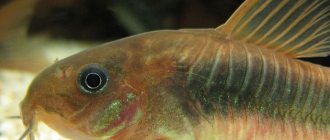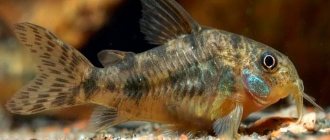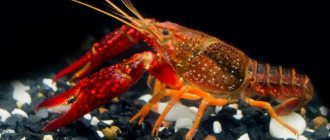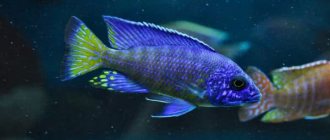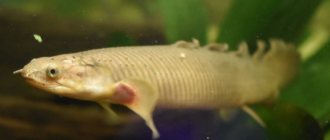Plecostomus (lat. Hypostomus plecostomus) is a species of catfish often found in aquariums. Many aquarists have kept them or seen them for sale, as they are very often used to solve algae problems. After all, this is an excellent aquarium cleaner, plus it is one of the most hardy and undemanding species of catfish.
Plecostomus has a very unusual body shape, with a suction cup-shaped mouth, a high dorsal fin and a crescent-shaped tail. He may roll his eyes so that it looks like he is winking. Light brown in color, it is covered with dark spots that make it darker.
But this catfish can be a problem for the aquarist. As a rule, fish are bought as juveniles, approximately 8 cm in length, but they grow quickly…. and can reach 61 cm, although in aquariums it is usually about 30-38 cm. It grows quickly, life expectancy is 10-15 years.
Habitat in nature
It was first described by Carl Linnaeus in 1758. It lives in South America, in Brazil, Trinidad and Tobago, and Guiana.
It lives in ponds and rivers, both freshwater and brackish, flowing into the Pacific and Atlantic oceans.
The term plecostomus means “folded mouth” and is applied to a wide range of catfish with similar mouthparts, although they differ in size, color and other details.
People call it pleco, armored catfish, etc.
There are many different catfish sold under the name Plecostomus. There are only about 120 species of Hypostomus and at least 50 of them are spotted. In this regard, there is a lot of confusion in classification.
Breeding
In their natural environment, individuals make deep, up to 2 m, burrows where they lay eggs. Catfish are bred in ponds; this is not possible in home aquariums. They do this in Singapore, Florida, Hong Kong. In this case, the reservoir must have steep slopes so that the catfish do not escape.
When they reach 30 cm in length, the male and female are ready to spawn. After the eggs appear (there are about 300 of them), the male protects his offspring. The fry appear after a few days. Then the reservoir is drained, the adults are removed, and the young are removed.
Description
Plecostomus has an elongated body covered with bony plates everywhere except the abdomen. A high dorsal fin and a large head, which only grows with age.
The eyes are small, set high on the head and can roll back in their sockets, making it look like it is winking.
The lower mouth, with large lips covered with spikes like a grater, is adapted for stripping algae from hard surfaces.
The body color is light brown, but appears much darker due to the large number of dark spots. This coloring conceals the fish against the background of the bottom of fallen leaves and stones. There are species with fewer spots or no spots at all.
In nature they grow up to 60 cm, in aquariums it is smaller, about 30-38 cm. They grow quickly and can live in an aquarium for up to 15 years, although in nature they live longer.
How to distinguish Plecostomus from Pterygoplichts
Pterygoplicht or Brocade catfish is similar to Plecostomus in appearance and lifestyle. Experienced aquarists see the differences between these individuals.
The Brocade Catfish has thick antennae, gill covers are brightly colored, the hard grater is pigmented and clearly visible, the folds of skin at the nostrils rise above eye level. Its dorsal fin is high, up to 15 cm long, has more than 10 rays, and the head is triangular in shape.
Plecostomus has thin mustache, its gill covers are pale, and skin folds do not extend beyond the level of the eyes.
Content complexity
It is very easy to maintain, provided it is fed abundantly with algae or catfish food, however, due to its size, it is not suitable for beginners, since very large aquariums are required for maintenance.
Water parameters are not so important, it is important that it is clean. Be prepared for the fact that the plecostomus grows very quickly and will need more volume.
They are nocturnal inhabitants, whose activity and feeding occurs with the arrival of darkness, so driftwood and other shelters should be placed in the aquarium so that they can hide during the day.
They can jump out of the aquarium, you need to cover it. Although they are omnivores, they primarily eat algae in the aquarium.
Young plecostomus are easy-going and can get along with most fish, even cichlids and other aggressive species. There is only one exception - they can be aggressive and territorial with other plecostomuses, unless they grew up together.
They also protect their favorite place from other fish that have the same feeding method. But adults become more and more aggressive and it is better to keep them separately over time.
It is also important to know that they can eat scales from the sides of other fish while they are sleeping. This is especially true for discus, angelfish and goldfish.
Despite the fact that they feed mainly on plant foods, they grow very large and can become a real problem for small aquariums.
Compatibility
By the nature of the catfish, Plecostomus are peaceful individuals; during the day they stay in shelter and do not disturb other inhabitants of the aquarium. They are active at night.
Small individuals get along with different fish. But the older they are, the more aggressive they are and do not allow anyone to be near them. Often adult Plecostomus are removed. Catfish exist peacefully with those who live in the upper and middle layers of the reservoir and with their relatives, if they first grew up together. If there is a lack of food, they gnaw the scales of other sleeping neighbors (angelfish, discus fish), and can eat small fish.
Compatible with barbs, aquarium sharks, discus, platies, bettas, zebrafish, swordtails, rainbowfish, American and African cichlids.
Feeding
Mainly plant food and algae, although it can also eat live food. It can eat soft species from plants, but this is if it lacks algae and nutrition.
For maintenance you need an aquarium with a lot of fouling. If it eats algae faster than it grows, you need to feed it with artificial catfish food.
Among vegetables, plecostomus can be given spinach, lettuce, cabbage, zucchini, and cucumbers.
From animal feed earthworms, bloodworms, insect larvae, small crustaceans. It is best to feed in the evening, shortly before the lights turn off.
Where does Plecostomus live?
Photo: Plecostomus in water
Plecostomus catfish are found in the fresh and brackish waters of the coastal drainages of the Guianas of Brazil and Venezuela, and in the Rio de la Plata between Uruguay and Argentina. They prefer fast streams and rivers with pebble substrate. This species is considered to be extremely adaptable and has been identified in the Gulf of Mexico, presumably introduced by aquarists. They are considered invasive in Texas.
They occupy a wide range of habitats, although a number of species have very limited ranges and are found only in certain parts of specific rivers. Many plecostomus live in fast, shallow streams and rivers, others live in acidic black water, and still others prefer quiet, brackish estuaries. In areas with high flows, they use their suckers to attach themselves to rocks and submerged trees, and thus avoid being carried downstream.
Plecostomus are typically found in soft, low-pH water in the wild, but many species sold today are commercially raised and tolerate a much wider range of water chemistry. A pH of 7.0 to 8.0, an alkalinity of 3° to 10° dKH (54 to 180 ppm), and a temperature of 23 to 27°C will be sufficient for most captive-bred species.
Now you know where the plecostomus fish lives. Let's see what this fish eats.
Keeping in an aquarium
For plecostomus, the volume in the aquarium is important, at least 300 liters, and as it grows up to 800-1000.
It grows very quickly and constantly needs free space for swimming and feeding. In the aquarium you need to place driftwood, stones and other shelters where it will hide during the day.
Driftwood in an aquarium is important not only as a shelter, but also as a place where algae grow quickly; in addition, they contain cellulose, which catfish need for normal digestion.
Loves well-planted aquariums, but can eat delicate species and accidentally pull out large ones. Be sure to cover the aquarium, they are prone to jumping out of the water.
As already mentioned, water parameters are not so important. Cleanliness and good filtration with regular changes are important, since for its size it produces a lot of waste.
Water temperature 19 - 26 °C, pH: 6.5-8.0, hardness 1 - 25 dGH
Temperament and adaptation
Young suckers live peacefully in the pond next to other inhabitants of the aquarium. But sometimes quarrels occur between their relatives.
As it becomes more mature, plecostomus no longer gets along so easily with its neighbors. He defends his territory and stops cleaning the reservoir. You can watch how the catfish attaches itself to the back of the fish and moves around the aquarium in this form for a long time.
One of the vital adaptive tools of the plecostomus is its mouth. It is designed in such a way that it allows the catfish to pick up leftover food from the bottom of the aquarium. The suction cup can stick to any surface.
This structure helps in the natural habitat. During the rainy season, the catfish is kept in its place, and the water carries other fish far from their native place of residence.
Just look at him:
In the intestines of the catfish there are miniature blood vessels in the form of a branched network. This allows the plecostomus to absorb oxygen dissolved in the atmosphere. This feature also helps with adaptation.
It has been established that catfish can remain in water for 30 hours without being in the water.
But the most incredible ability of plecostomus is their ability to move along the surface of the ground, thanks to a well-developed tail and fins on the chest. This property allows you to move long distances (for example, when a reservoir dries up).
Plecostomus price and compatibility with other fish
The price for a plecostomus in a regular pet store is not very high - from 100 rubles. This figure can be significantly higher if the fish has already grown to a large size, or has an unusual and bright color. That is, the more impressive the plecostomus looks, the more expensive it is.
Catfish can get along with any species of fish, as they have a rather peaceful character. However, it can compete with other catfish, especially if there are not enough separate shaded areas in the aquarium, or if the fish do not receive enough nutrition.
Diseases and prevention
How long catfish live depends on their care, but the maximum lifespan in aquarium conditions is 15 years. Plecostomus has excellent immunity and rarely gets sick.
Possible diseases - ichthyophthyriosis, fin rot, oxygen starvation, nitrate poisoning - are associated with poor-quality feeding and improper maintenance. For prevention, you need to choose high-quality food and change the water regularly.
Plecostomus is a useful fish that cleans the aquarium of excess algae. Thanks to its interesting behavior and large size, it becomes a favorite pet and almost a friend for aquarists.
What does Plecostomus eat?
Photo: Plecostomus catfish
Most Plecostomus are marketed as "algae eaters", which would lead you to believe that they are herbivores; however, most are carnivores and can feed on small fish, invertebrates and crustaceans. Some species also feed on wood, so make sure you thoroughly research the exact species you're interested in to check you meet their dietary requirements.
When it comes to the common plecostomus, a common misconception is that they can live exclusively on algae. This is not true, because such a diet actually leads to exhaustion of the fish, and is very harmful to their health. Their diet should consist of vegetables and seaweed; Sometimes they can eat meat/live food. It is recommended that high quality pellets form the basis of a plecostomus' diet.
Plecostomus can be fed the following vegetables:
- salad;
- zucchini;
- spinach;
- peeled peas;
- cucumbers
Suitable live food:
- blood worms;
- earthworms;
- crustaceans;
- larvae.
It is important to remember that plecostomus require a lot of fiber in their diet; Feeding them plenty of vegetables helps meet this animal need. You should also make sure they always have access to driftwood, which can help with their digestion. For best results, feed your plecostomus a variety of high-quality foods and change your fish's diet daily. In terms of feeding habits, plecostomus are nocturnal. Thus, they eat best in the evening before you turn off the lights in the aquarium.
Range and Habitat
Plecostomus (Hypostomus plecostomus) distribution sites.
Widely distributed in tropical waters of Central and South America, in the Amazon River basin (Brazil, Guyana, Suriname, Venezuela, Trinidad, Costa Rica, Panama, Uruguay).
The Plecostomus family includes a large number of subspecies, sometimes difficult to distinguish by appearance.
Plecostomus (Hypostomus plecostomus) habitat, biotope.
It lives in fresh flowing, oxygen-rich water and in brackish waters of river mouths. Plecostomus exists in a wide variety of tropical forest environments. They are found both in fast-flowing rivers along the slopes of the Andes mountain range high above sea level, and in underground rivers completely devoid of sunlight, where few fish dare to settle. Such a huge ability to adapt to completely different environmental conditions was developed in them in the process of evolution and provided them with highly developed survival mechanisms.
Natural enemies of plecostomus
Photo: What plecostomus looks like
Representatives of Plecostomus can be consumed by birds (cormorants, herons and pelicans), alligators, crocodiles, otters, water snakes, freshwater turtles and predatory fish, including large catfish and largemouth bass.
Many predators have difficulty swallowing plecostomus due to the fish's spines and body armor, and birds (pelicans) have been observed to die trying to swallow large specimens. An adaptation to reduce predation is the protective posture these fish exhibit when they are mistreated or threatened: the spinal fins are stable and the fins are flared, making the fish larger and thus more difficult for enemies to swallow.
Fun Fact: The name "plecostomus" is Latin for "folded mouth", referring to the suction cup-like mouth of this catfish that is located under the head.
But most often, plecostomus themselves are enemies of other fish. For example, Dionda diaboli (Devil's River) and Etheostoma fonticola (Darter Fountain) are endangered due to the impact of plecostomus. These species compete with each other for the right to monopolize resources, and the hero of our story undoubtedly wins this battle.
Features of character and lifestyle
Photo: Plecostomus fish
The first thing you need to know about this fish is that it is nocturnal. This means you won't see much activity during the day. They may appear shy during the daytime, and you will likely find them hiding among the plants and caves inside your aquarium.
During their active period, you will notice that they are bottom-dwelling fish and will slowly move along the bottom of the aquarium. By moving slowly along it, they do an excellent job of cleaning the algae in the aquarium. You will also notice that they use a suction cup and attach to the glass or rocks in the aquarium. It is important to note here that although they will eat algae, their diet should not consist solely of algae. Many pet stores advertise them as algae eaters, which is dangerous because they have different nutritional requirements.
Plecostomus generally have a friendly personality and are quite peaceful when young and can be kept in a public aquarium. Ideal neighbors of plecostomus are cichlids, macropods (guramids), tetras and other fish species. But even when young, you should avoid placing it with discus and angelfish, as plecostomus are known to prey on them.
Fun fact: Any smaller tank mates should not be able to fit into the plecostomus's mouth; if this is possible, then such fish will very quickly become dinner for him.
As Plecostomus ages, it will quickly outgrow other fish and should be kept in its own tank without any neighbors.
